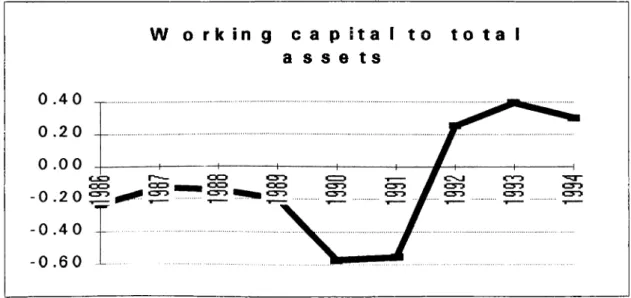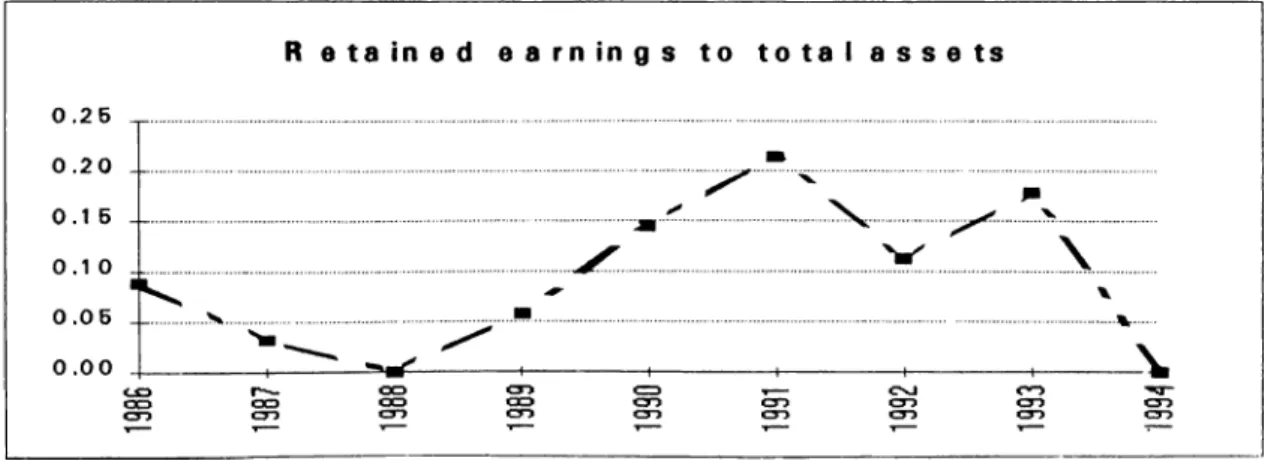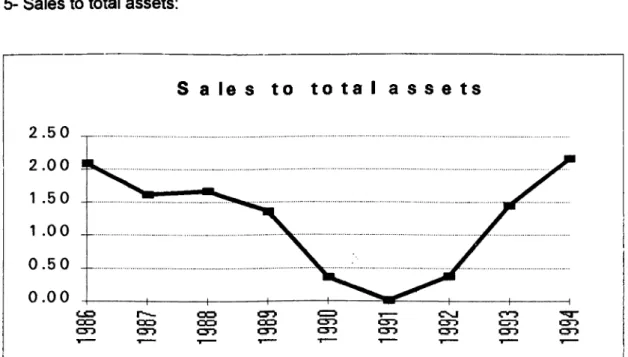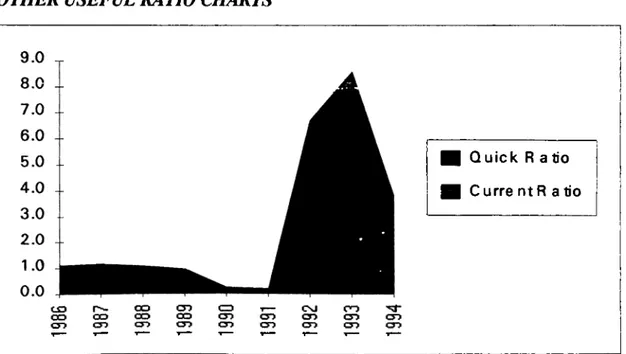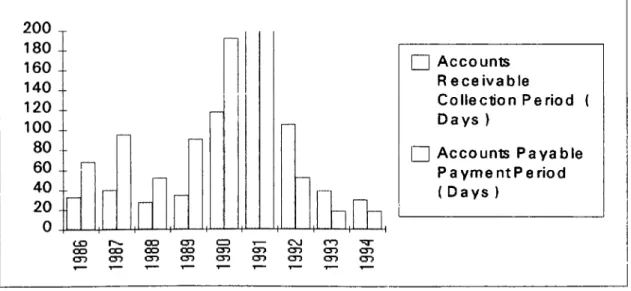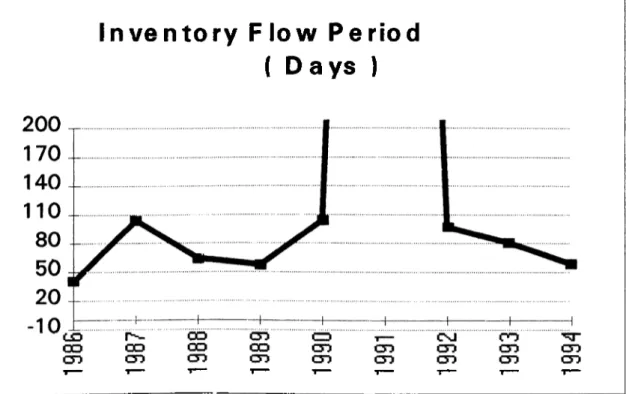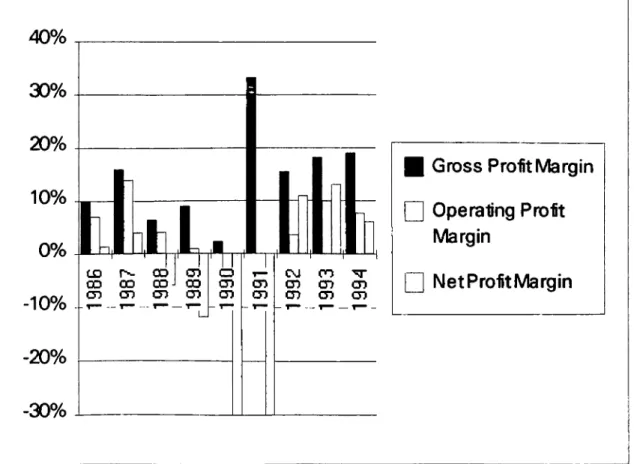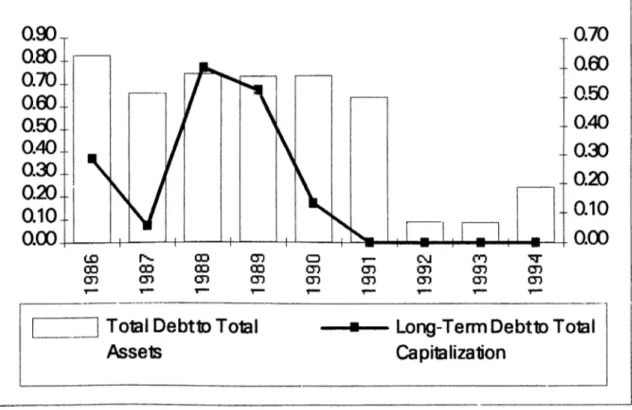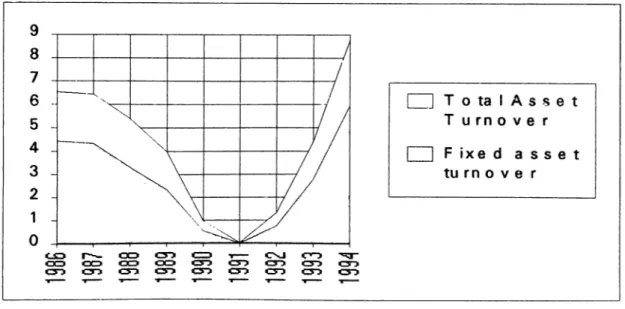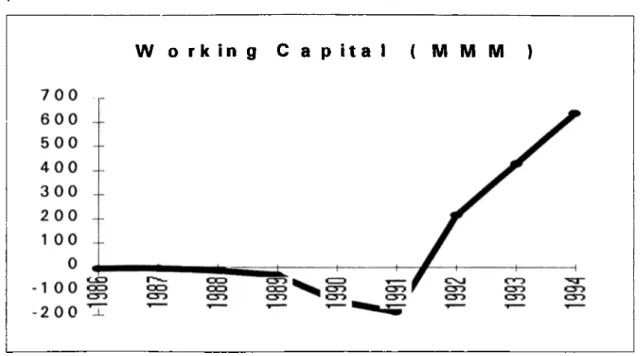META§’ TURNAROUND CASE : A STUDY ABOUT THE
TURNAROUND STRATEGIES AND THE RELATED
DECISION STREAMS SHAPING THEM.
MBA THESIS
BY
TOLGA TUZUNER
SEPTEMBER 1995
m
• T 2 9
I certify that I have read this thesis and in my opinion it is fully adequate, in scope and quality, as a thesis for the degree of Master of Business Administration.
/ ' -
Assistant Professor Dr. Oğuz BABÜROGLU
I certify that I have read this thesis and in my opinion it is fully adequate, in scope and quality, as a thesis for the degree of Master of Business Administration.
c^.
Assistant Professor Dr. Erdal EREL
I certify that I have read this thesis and in my opinion it is fully adequate, in scope and quality, as a thesis for the degree of Master of Business Administration.
Assistant Professor Dr Serpil SAYIN
Approved for the Graduate School of Business Administration
[')
ABSTRACT
METAL’S TURNAROUND CASE : A STUDY ABOUT
THE TURNAROUND STRATEGIES AND THE RELATED
DECISION STREAMS SHAPING THEM.
BY
TOLGA TUZUNER
SUPERVISOR: ASS0C .PR 0F.06U Z BABURO
6
LU
SEPTEMBER 1995
Meta§ which is the first private steel factory with arc furnace technology, begins to implement the “turnaround” strategy during the 90’s. This case aims to determine the reasons that cause the turnaround strategy and the strategic decision streams through the turnaround.
Meta$ could not succeed financially in the extensive competition of the 80’s eventhough having better production techniques compared to it’s competitors, having a company image accompanied by the “quality” concept, and sufficient social right given to its workers.
After the production was stopped it began to exercise turnaround strategy by the help of the funds that were injected by the government. Production started again and necessary structural changes were done. As during the privatization period the government gave way to survival by nationalization, this regeneration period has a special feature. Also it’s importance comes from the fact that this case is a successful example of a turnaround that was done by a big scaled firm in Turkey.
In this case, the Meta§’ turnaround is examined. Starting from the reasons creating crises together with the environmental conditions the case is set on the general turnaround explanations. In the research part, the chronological determination of strategic areas results in generic strategies. So by this method, the strategic ways reaching to turnaround strategies and the effects of turnaround strategy on Meta§’ organizational life is examined.
ÖZET
METAŞ’IN TURNAROUNDU ; TURNAROUND
STRATEJİSİ VE BU SEÇİMİ OLUŞTURAN
STRATEJİLERİN GELİŞİMİ HAKKİNDA BİR ÇALIŞMA
TOLGA TÜZÜNER
YÜKSEK LİSANS TEZİ İŞLETME FAKÜLTESİ
TEZ DANIŞMANI : Doc. Dr. OĞUZ BABÜROĞLU
EYLÜL 1995
Bu olay çalışması ilk özel ark ocaklı demir çelik tesisi olan Metaş’ın 1990 yılı içinde uygulamaya başladığı turnaround stratejisini, kendini oluşturan nedenler ve sonucunda oluştuğu strateji akımları yardımı ile incelemeyi amaçlamaktadır.
Metaş birçok rakibine göre modern olan tesislerini, kalite kavramı ile birleştirdiği imajına ve çalışanlarına sağladığı sosyal olanaklara karşın seksenlerin getirdiği yüksek rekabet koşullarına ayak uyduramayarak zaman içinde finansal açıdan zor durumda kalmıştır. Firma üretimini durdurduktan sonra turnaround stratejisine girerek kendine gereken fonları devletten sağlamış, gerekli yapısal değişiklikleri yapmış ve yeniden üretime geçmiştir.
Metaş’ın yeniden üretime dönmesi özelleştirme döneminde yapılan bir devletleştirme işlemi olduğundan son yıllarda güncelliğini hiç kaybetmemiştir. Turnaround açısından ise büyük ölçekli bir firma için tam anlamı ile başarılı bir örnek teşkil ettiğinden önemlidir.
Bu çalışmada, firma içinde bulunduğu çevresel koşullar ve krizi yaratan nedenlerle birlikte İncelenmekte, turnaround stratejisi kavramının daha önce pek de incelenmemiş yapısı tanımlandıktan sonra buraya “Metaş turnaroundu” oturtulmaktadır. Bir inceleme olarak da firma için önemli olan stratejik alanlar belirlenmekte burada oluşan stratejiler zaman boyunca çıkarılmakta, bu stratejilerden de firmanın generic stratejilerine ulaşılmaktadır. Böylece turnaround stratejisine giden stratejik yol ve firmaya
TABLE OF CONTENTS
PREFACE... 1
PART 1
“TURNAROUND” IN GENERAL...3
TYPES OF TURNAROUND STRATEGIES... 4
STEPS OF A TURNAROUND... 5
CHANGE IN MANAGEMENT... 5
CONSIDERATION...6
RADICAL AND URGENT SOLUTIONS...8
STABIUTY... 10
NORMAL GROWTH...11
PART 2
THE COMPANY “METAŞ” ... 13
ENVIRONMENTAL FACTORS... 14
STEEL PRODUCTION SECTOR... U
Environment... 18
THE REASONS CREATING CRISIS... 24
PARTNERSHIP OF İŞ BANKASI AND İZMİR DEMİR ÇELİK... 24
THE DUTY BROKE DOWN IN STEEL INDUSTRY...26
CRISIS IN STEEL PRODUCTION IN THE WORLD... 27
OWNERSHIP OF BERUN FACTORY... 28
THE UNSUCCESSFUL KRUPP PROJECT... 28
INCREASING RAW MATERIAL PRICES... 29
THE FINANCIAL IMPROVEMENT AND CRISIS... 30
BALANCE SHEETS INCOME RATIOS AND RATIOS...30
REGENERATION SCENARIOS...40
PART 3
META§’S TURNAROUND... 45
NEW MANAGEMENT... 45
CONSIDERATION... 46
RADICAL AND URGENT SOLUTION’S ... 47
STABILIZATION - THE BEGINNING OF A NEW ACTION... 49
NORMAL GROWTH - STEAMING... 50
PART 4
STRATEGIC FORMATION TOWARDS TURNAROUND...53
THE FORMATION OF STRATEGIC AREAS... 53
TRACING IN THE KEY STRATEGIC AREAS OF META§ CASE DURING
THE TURNAROUND... 54
KEY STRATEGIC AREAS & THEIR STRATEGIES... 57
FINANCIAL STRATEGIES... 57
QUAUTY MANAGEMENT STRATEGIES...61
HUMAN RESOURCE MANAGEMENT STRATEGIES...63
RESEARCH & DEVELOPMENT MANAGEMENT STRATEGIES...65
MARKETING - SALES STRATEGIES...66
GENERIC STRATEGIES OF THE META§ GROUP... 68
CONCLUSION... 70
EXHIBITS...
TABLE OF FIGURES...
TABLE OF FIGURES
FIGURE
1 W ORKING CAPITAL TO TOTAL ASSETS 31FIGURE
2 RETAINED EARNINGS TO TOTAL ASSETS 32FIGURE
3 EARNINGS BEFORE INTERESTS AND TAXES TO TOTALASSETS 32
FIGURE 4
SALES TO TOTAL ASSETS 33FIGURE
5 QUICK AND CURRENT RATIOS 34FIGURE 6
ACCOUNTS RECEIVABLE AND ACCOUNTS PAYABLE RATIOS 35FIGURE 7
INVENTORY FLOW PERIOD 36FIGURE 8
PROFIT MARGINS 37FIGURE 9
DEBT ASSET RATIO AND LONG TERM DEBT TO TOTALCAPITALIZATION RATIO 38
FIGURE 10
ASSET TURNOVER RATIOS 39FIGURE
11 RETURN ON EQUITY AND RETURN ON ASSETS RATIOS 39FIGURE
12 W ORKING CAPITAL RATIO 40PREFACE
Turnarounds are of increasing relevance. Global competition, technological turbulence, high costs of capital and other nettlesome factors will cause more and more businesses to face occasional hard times. Businesses in mature industries face particularly difficult turnaround situations. Demand is flat, customer loyalties are relatively strong and competition is generally zero sum.
The purpose in writing thesis about the Metaş’ turnaround was twofold: To provide a group explanation of a turnaround strategy which is under the shadow of retrenchment strategy in the strategic management books, and to create a strategic decision stream towards the turnaround strategy.
This thesis includes four parts. In the first section, the general concept of the turnaround strategy was examined. In the second part of the thesis, Metaş is introduced with the environmental trends and the reasons causing the crisis. The implementation of the turnaround in Metaş is examined under the first stage’s findings. In the last stage the strategic decision streams towards turnaround are considered. From functional areas to generic strategies every strategy evolution was examined in time; especially the appearance of the turnaround strategy is plotted on the time scale of the strategic flow.
The reasons for choosing Metaş as a model for turnarounds were the company’s remarkable specifications. First of all, Metaş is attracting public interest from 1990 until now. And although it has been facing financial problems, it has been in Turkey’s top 100 firms list.
Besides that the easy access to Metaş by the help of Oğuz Babüroğlu’s project, the easily reachable information about the factory, and the public interest to the problem were the other reasons for selecting Metaş as a case study.
“TURNAROUND” IN GENERAL
Turnaround strategies are designed to restore the health and viability of an enterprise following a period of decline. Retrenchment and turnaround are often linked since cut backs are usually part of an overall plan to improve organizational performance. Retrenchment differs from turnaround in that retrenchment is a pull back and leaning up in face of adverse conditions. The strategic posture of retrenchment is defensive. However retrenchment is considered to be a part of a turnaround strategy. Turnaround strategy’s first phase consists of a defensive act like retrenchment but moreover it is followed by a steaming of the corporation phase.
Turnaround managers try to bring order to chaos, which usually means they must take control of every function in the business. They create budgets from the bottom up and strictly enforce accountability.
The amount of time required for a turnaround differs depending on the researcher. Hofler’s research stated that the average time of a successful turnaround elapsed from through to peak was three years. The whole range observed was one to four years. ^ But the research of Bibeault’s showed that the average elapsed time from beginning to end is four years. Bibeault also noted that the time required for a turnaround is a function of the size of the organization^.
No matter what type of operating turnaround strategy is followed, the limited financial resources and time urgency associated with most operational turnaround situations require that particular attention be given to all actions that will have a major cash flow impact on the business in the short term.^
‘ Charles W. Hofer, “Designing Turnaround Strategies”, Managing Transition, p.679.
^D.G. Bibeault, “Corporate Turnaround: How Managers Turn Losers into Winners” Newyork: McGraw-Hill, 1982, p.307.
There are two factors that are important in describing turnaround situations. They are the areas of organizational performance affected and the time critically of the turnaround situation.^
TYPES OF TURNAROUND STRATEGIES
There are two board types of turnaround strategies that may be followed at the business level;
1) Strategic turnarounds,
2) Operating turnarounds.
Strategic turnarounds are appropriate when the business is in a noncrisis situation but has lost position strategically.
In strategic turnarounds, the focus is on the strategy changes sought with the performance produced being a derivative of the strategy change.^ Strategic turnarounds are of two types; Those that involve a change in the organization’s strategy for competing in the same business and that involve entering a new business.
Operating turnarounds are usually one of four types, none of which involves changing the firm’s business-level strategy as in the strategic turnarounds. These are non strategic turnarounds that emphasize:
a- Increasing revenues,
b- Decreasing costs,
c- Decreasing assets,
d- A balanced combination of the three types.
^Ibid., p.683.
’ Frank T Paine, William Naumes, Organizational Strategy & Policy Text and Cases, The Dryden Press, 1982, p.94-95.
In operating turnarounds the focus is on the performance targets, and the actions through which they can be achieved are to be considered wtienever they make long run strategic sense.
Another broad type of turnaround can be specified as financial turnaround. In this kind the company restructures its financial operations. The objective is to utilize the financial strength of the business. The financial turnaround is seen as a part of operational turnaround by some of the authors.
STEPS OF A TURNAROUND
Five basic steps that are described for a turnaround by the researchers are. change in management, consideration, radical and urgent solutions, stability and streamlining.
CHANGE IN MANAGEMENT
Only 20 percent of business failures are caused by external elements. The other 80 percent are the result of mishandled internal elements. Management is the source, that drives the internal functions of finance, production and marketing/distribution, and yet these elements are the root of the majority of the business failures.®
The inability of upper management, not very experienced in turnaround management, to handle the situation is the first problem to be faced in a turnaround. An organization’s managers often begin to believe that their management style and methods can not fail. Since what they have done in the past was successful, they tend to rely too much on past experience as a guide to future action.^ Management incorrectly assumes that business can continue as usual. Because the normal business practices have placed the firm in mortal jeopardy, they cannot continue. Long standing employees will need to be fired. Old product lines associated with the company name will
‘’Scott P. Schenrer, ‘Trom Wanting To Crisis; A Tuntaround Strategy”, Management Review, September 1988, p.30.
’ Arthur G. Bedeian, Raymond F. Zammuto, Strategic Management Focus On Process, 3rd Ed.; Me Graw- Hill Inc.,1990, p.486.
have to be eliminated. Plants that are the keystones of local economies will have to be closed. Policies and procedures will need to be replaced. The people responsible for the past cannot usually bring themselves to make these types of changes.
Leadership of a turnaround, therefore is usually put in the hands of someone new, someone without a past (from the employees perspective). This person must have the needed freedom and ability to act. If he or she cannot act decisively and quickly, the turnaround is probably doomed.
It is a perception that in all successful turnarounds, the replacement of the current top management of the business is necessary. There is, of course no law written in stone that the firms current top management team can not supervise a successful turnaround. Usually however, the old management has such a strong belief about how to run the business in question, many of which must be wrong for the current problems to have arisen, that the only v/ay to get a new view of the situation is to bring in a new top management. There will, of course, be some expectations to this generalization as there are to all generalizations.° Accepting this comment, the researches of Kami and Ross (1973) and Schandel, Patton, and Riggs (1976) show us that 95 percent of the successful turnarounds had begun with a new management team.
It is foolish and needlessly expensive to replace an entire management. There must also be a link between the new turnaround management and the existing middle management and professional staff. This link should also be present between members of the previous management who are found to be competent and able to react to the changed circumstances.
CONSIDERATION
A turnaround has to start with an evaluation of the company’s strengths and weaknesses in relation with the competition and the political interest groups. The other important issue is the decision of turnaround. Is the
company worth the turnaround effort? This is a fundamental question. The bottom line is the net present value of achieving the turnaround. The troubled company may be the victim of an industrial, technological or structural change, or it may be faced with a huge worldwide permanent capacity surplus in its industry. It may have many far larger and more capable competitors. It may be one of the participants that does not deserve to survive the shake out.
Before trying to decide the strategy for turnaround, three questions should be asked;^
1- Is the business worth saving? More specifically, can the business be made profitable in the long run or is it better to liquidate or divest now? And if it is worth saving, then.
2- What is the current operating health of the business?
3- What is the current strategic health of the business?
The types of turnaround strategy that should be selected by a firm will vary with its current operating and strategic health. Operating-Strategic or mix strategies can be selected by the management. Once the business has selected the type of broad turnaround strategy it should use, then it needs to select the more specific aspects of turnaround strategy. The details of these strategic action plans will depend, on the exact nature of the industry in which the business competes, its strengths and weaknesses and other competitors in the industry.
It is important to match the type of turnaround to the case of decline. If the underlying cause is a structural shift in markets, the response should be strategic turnaround, which involves changing the product/market mix. If the decline relates to internal efficiency, the organization should seek ways of increasing revenue, cutting costs and decreasing assets, i.e., engage in operating turnaround.
Organizational survival has repeatedly been linked to effective strategy making “doing the right thing” in the face of competitive and market forces, and enabling the organization to achieve its objectives.
A strategy that makes good sense will be of no use if, for example, powerful interest groups are able to block it. Consequently, successful managers will be assessing the political as well as economic implications of strategy making. The business literature views turnaround primarily as an economic problem when it is, in fact, also a political problem. The turnaround process has a political dimension because of the various interest groups that have a stake in the rundown and recovery process.
The turnaround leader will need to rapidly develop a strategic concept of the business. That is, he or she will need to define the corporate objective, a specific statement of business purpose.
Companies have stated a plan for all the various types of turnaround activities. The sum of the individual departmental or functional turnaround plays may be considered as a form of master plan. A hit or miss approach will fail because too many types of changes must be defined and implemented at the same time
RADICAL AND URGENT SOLUTIONS
In the case of turnarounds the implication of radical and urgent solutions to the problems is important. At this stage the management managed the business to produce immediate and certain results. They concentrate on the actions that are decided in the consideration stage that would have immediate impact. While implementing fast actions through the decided strategy, management must be careful not to handout their future. This is the hardest stage of the process. It is one thing to maintain and increase
Cynthia Hardy, Strategies fOT Retrenchment and Turnaround; the Politics of Survival, Berlm; Walter de G niyter& Co., 1989, p. 136.
existing momentum; it is quite another to change direction and take steps necessary to reverse momentum when it is going against the com pany/’
The case studies clearly show that success depends upon identifying the potential opposition groups and devising a strategy that deals with their concerns. In this way, conflict is preempted and the chances of successful implementation increased.’^
The turnaround management faces a number of powerful constituencies that will have major effects on the key elements of the turnaround process. They are board of directors, lenders, government, labor unions and shareholders. As a rule, the approach the companies take in achieving a turnaround must be made known and sensible to these external groups. They have to be convinced that the proper actions, programs, reorganizations, and the like should be implemented. They must believe that their best interests are served by supporting the turnaround effort and that, within a reasonable period of time, the company will once again be viable. Banks, vendors, customers, board of directors and others who are affected by the decline of the business need to be made a part of the solution.
Turnaround will depend on the ability to maintain high level of morale, motivation and commitment which is particularly important when scare resources escalate levels of political conflict.
People are the heart of successful turnaround. The employees of a company must want the turnover occur and feel personally involved in achieving it. A sense of urgency, care, and participation must permeate the environment. Deliberate team building measures must be instituted to covert dispirited employees into believers, who are confident that the turnaround will succeed, that the company will survive, and that they will
'* A.W.Clausen, “ Strategic Issues in Managing Change: The Turnaround at BankAmerica Corporation”: Strategic Planning, 1982.
'^Ibid.,p.l37.
continue to have a future as employees. What ever company aches for it certainly will achieve through the actions of its employees, not just through the few in the upper management. Top management can not lose sight of this fact14
In a turnaround management should constantly communicate about credibility, consistency, and confidence both inside and outside the organization. Immediately an employee communications program must be set up which makes the employees part of the effort to solve the company’s problems. People need information if they are to respond appropriately and they should be properly motivated. All people fear unknown especially loosing their jobs. They need to know what is going on. How bad sales and loses are; what management will be doing to save the company; what they are expected to do. A sense of personal involvement and urgency in doing their jobs will exist only if the employees feel that they are the part of the organization. No corporate turnaround is a result of one individual work alone. Success is the result of melding and motivating a team.
Improving operations alone is usually not enough to achieve a successful turnaround. You must pay particular attention to cash flow. Cash generation is a need to overcome the rough spots, while cash demands have to be reduced.
STABILITY
In this stage organization can determine the further action impacts over the organization while current operations continue.
In stabilization firms maintain their sizes and current lines of business while organizational rebuilding starts. The human resource management, production management styles, information systems and like have to be reshaped for the organization’s future. New technologies are searched for better production results. The coordination of the firm has to be increased. New management skills involving team work and total quality approaches
have to be put in action. The most importantly, companies must streamline corporate decision making for reaching better solutions to the problems.
In stabilized companies managers may continue to manage as if the growth will continue in the near future. Encouraged by the progress, staff members will begin to become enthusiastic and start contributing with their own ideas and suggestions. The turnaround's chain reaction has begun. This is the beginning of the new corporate culture.
NORMAL GROWTH
Although the short term strategies focus on the urgent solutions like cost reduction or urgent strategic moves, longer run strategies may be aimed at growth or holding strategies.
This is the upturn phase of the turnaround. New growth strategies begin to implement. A growth strategy is selected to increase profits, sales (development of new products), or market share (new markets). Growth may be pursued to lower per unit costs or to satisfy managerial motivations.
The management has no choice but to reduce overall employment levels to cut expenses. The employees who remained with the organization during the implementation of turnaround must carry high responsibilities. The work that the employees do is valuable, and therefore, they should be compensated for this. In the last stage of turnaround, management must create a culture, based upon teamwork, that both recognize and reward employees for their efforts in implementing strategies that produce the desired results.
THE COMPANY “METAŞ”
Metaş, one of the oldest steel producers in Turkey was founded by Raşit Ozsaruhan in 1954 with the steel arc capacity of 15.000 tons per year. While the company’s principal production facility was located in İzmir, the other conversation and port facilities were situated in provincial cities. Metaş is the oldest private steel producer that uses arc ovens during production. Because of the Ozsaruhan family’s management perspective, the factory was always open to innovations and employee development programs.
In 1989 Metaş had the third biggest industrial capacity after Tüpraş and Alpet in the region of Ege. Today Metaş is the 7th largest private steel producer in Turkey with a capacity of over 490.000 ton per year. It has integrated production of steel with two steel ovens and two steel mills. The company's product line is divided between semi-finished (blaum) and finished goods which consist of a variety of long products and also quality long products. (Exhibit 4)
Metaş was indirectly owned by Ozsaruhan family in the beginning of the production stop. Moreover it is also 40 % open to the public and some well-known minor partners like Koç Holding and Türkiye İş Bankası were also in the partnership.
As being open to the public, Metaş obeys the rules of Securities and Exchange Commission that bring obligations as free information flow and detailed financial information.
Metaş is the first private steel producer who used the electric arc furnace technology. This technology uses electricity to melt scrap iron to produce steel blooms and has big cost advantages on the old coal furnace production technology. As a result of being the first in this area the factory has become a school for the new ones entering the industry. The new
openers generally attract workers and managers from the facility to set their production lines.
There are always good training programs and partnerships with European and Japanese steel makers for new production techniques that brings work satisfaction and dynamism to the working environment. Because of having qualified workers, the factory has generally paid above average salaries.
As it is located in the suburbs of İzmir, the company has always been a good choice for qualified workers and engineers. Metaş employs over 1500 people including its partnerships and has a good company recognition in the region.
Metaş is open to innovations that bring some useful investments and some unsuccessful attempts as well. There are four worldwide first applied renewals and twenty-four Turkey wide, first applied renewals made in Metaş.
ENVIRONMENTAL FACTORS
STEEL PRODUCTION SECTOR
STEEL PRODUCTION SECTOR IN THE WORLD
iron and steel products are indispensable for key sectors which stimulate economic resurrection, namely construction, automotive and consumer durable industries. As such, the state of an economy is directly reflected on the performance of the iron and steel sector’®.
There are basically two kinds of steel: long and flat. Flat steel needs a very expensive investment for production and used in industries like car making and long steel can be called as construction steel. The production technologies are so different that a factory producing long steel cannot produce flat steel and vice versa. The world production is divided into half and half for both kinds of steels. However the demand for the flat steel is
bigger than the long steel in industrialized countries and the reverse is true for developing countries.
There is a second differentiation in steel that may be called “normal and quality steel." Quality steel has some special production mixes and techniques that needs high quality scrap use during the production that can be produced by experienced workers. As this kind is used in high tech constructions and industries there is no seasonality in its demand.
Steel industry grew very fast in 1980s, because of the global trade due to the demand in the industrialized countries and the new capacity increases in developing countries. Besides this big growth with the beginning of the changes in the world trade policies, Eastern Europe’s low cost steel exports created an over capacity in the global market. In addition to this, the demand decrease in the developed countries in the last half of’ 89 due to the economic shrinking appeared as a crisis in steel trade so in the sector of production as well.
Lack of demand has caused the steel producers to reduce production and led developed countries with high growth rates to increase their production share, improve their technologies and become self sufficienO^.
Due to the cyclical nature of the industry the production at times rises in excess of the demand. This in turn forced steel producers to look for alternative markets to sell their products. However, in an environment where industrial nationalism was peaked and new technologies were being introduced by allowing more steel to be produced at lower prices, the world steel industry became very competitive. Moreover, Eastern European countries that were in desperate need for hard currency, were folding the market with cheap steel products deepening the slump and making it longer lasting.
Every nation’s steel industry had governmental supports because it is considered as one of the core industries with huge employment potential. Therefore, every developing country wanted to have their own steel production to break the dependency to the developed countries.
In 1980s there was a concept of privatization in the developed countries for steel industry. The state owning was decreased from 31% to 25%. This was because of the EC’s subsidy restrictions and big costs of the sector on governments.
STEEL PRODUCTION SECTOR IN TURKEY
Turkish steel industry is considered to be the locomotive sector of the Turkish economy. Currently there are more than 20 different companies in the sector four of which being state owned. After the developments in 80s, in line with the growing economy the production increased gradually. The production in 1994 was 12.5 million tons whereas in 1980 the production was only 2.4 million tons.
Turkey, with her 12.5 million tons per annum, ranks 15th in world crude steel production. Although the value added is in flat products which serve the automotive and durable industries, the incentive scheme designed for the private sector in Turkey has promoted long products making construction sector the major market. 31.2 % of total domestic production is realized by the public sector while the rest is covered by private furnaces. The global trend is toward integrated plants capable of producing flat products and all such plants are state monopolies in Turkey. In this context the wave of privatization efforts attracts considerable attention of the Turkish private sector that is aware of the need to undertake sizable modernization investments.
Domestic production of steel in Turkey is 15 % in flat and 85 % is in the long form (for comparison, EC figures are 65 % flat and 35 % long products). This in turn creates a structural imbalance as the domestic demand for flat steel exceeds the demand for long steel products. Moreover, growing
volume of steel imports is further aggravating the problem. As an outcome of this imbalance while the excess demand for flat steel has to be met through imports, long steel producers need to export most of their production.’^ (Exhibit 3)
The industry has reached this situation because of government policies such as inappropriate production incentives, high tariffs and quotas. However in the government incentive programs of the coming years, policies seem to change : incentives regarding long steel will be for modernization and R&D, not capacity expansion, flat and quality steel production will be encouraged.
Survival of the sector largely depends on the success in the world market since the only solution seems to be exporting the slack production. The Turkish government provides subsidies in terms of freight premium ranging between $ 20 to $ 40 in order to aid exports till the beginning of 1995.
Since raw materials needed for steel production are not abundant in Turkey, steel producers need to import a relatively high proportion of their raw material requirements. Also, some non-integrated, rather small producers import steel in slab, ingot and scrap to deform them afterwards to final shape. The industry is dependent on external suppliers. The imported scrap metal that is used as the raw materiel in steel production accounts for 65% of the total production cost. The increase in import prices; however, is not reflected right away on the exported goods’ prices. At this juncture, the government export incentives consisting of fright and energy usage premiums come into picture for being successful in global market.
China, Hong-Kong, USA, North Africa are the largest export destinations of Turkish iron and steel.
Environm ent
Each organization exists within a complex network of environmental forces comprised of the national and global macroenvironment and the industry in which the organization competes. Because these forces are dynamic, their constant change presents numerous opportunities and threats or constraints to strategic managers.ie
An essential part of company strategy is a plan for adapting company action to its environment. This is no simple matter because the environment is continuously changing. New technology, social shifts, political realignments and pressures, as well as the more commonly recognized economic changes, all create problems and opportunities^^.
The environment affects both a firm’s initial conditions and it’s managerial choices. It influences the ability of firms to carry out particular types of strategies, hence limiting choice.^“
The environment of an organization is generally divided into three distinct levels: the general environment, the operating environment, and the internal environment^^.
GENERAL ENVIRONMENT
The general environment is that level of an organization’s external environment made up of components that are normally broad in scope and have little immediate application for managing organization. Social, economic, political, legal, technological issues are the components of general environment22
Wright, Pringle and Kroll, Strategic Management Text and Cases, Massachusetts; Simon & Schuster Inc. 1992, p.36.
'^Newman, Logan, Strategy, Policy, and Central Management, 7th ed. Ohio: South-Western Publishing C., 1976, p.31.
“ Michael E. Porter, Towards A Dynamic Theory of Strategy, Strategic Management Journal, Voll2, No 95- 117,1991, p.97.
Samuel C. Certo, J. Paul Peter, Strategic management Focus On Process, 3rd ed. Newyork: McGraw-Hill, 1990, p.32.
COOPERATION OF IZMIR’S BUSINESS ENVIRONMENT
Aegean district especially İzmir has a private place in Turkey’s Commercial life by having %13 of Turkey’s gross national product. This district has some special characteristic with its firms and executive profiles, with the businesses close to the families and the powerful bosses in the firms.
Izmir business life, holds the firms and businessmen closer to each other. Because of having a dependency to Ankara for governmental reasons and a dependency to Istanbul for financial reasons, the close relations inside the region and a notion of sacrifice is advanced.^® In the times of crisis the region's business factors help each other.
Izmir’s business environment is closer to the social events and they do not forget the humanitarian sides of the events. Furthermore the political vote potential reflects the importance of social thoughts.
THE STRATEGIC IMPORTANCE OF İZMİR BETWEEN POLITICAL PARTIES, PARLIAMENTARIANS AND VOTE POTENTIALS
Izmir has political importance in Turkey’s political life. Because of being an industrialized region there is a high population with a big vote potential. Besides the political parties the lobbies inside the parties have big quarrels about this region.
As having qualified agriculture and sufficient industry, the region can be seen as one of the richest regions in Turkey. This welfare brings this region the upper requirement of the human needs so the social rights become more important support for working life. With the social needs the left vote potential increases and Izmir is seen as the left parties castle. However in the last years of 80’s the ANAP governments' policies found support from the Izmir’s trade life so the vote potential of this party also increased in Izmir.
In the last part of 1980’s the vote potential and the increased political uncertainty created quarrels besides the political parties for the coming
elections. The left side parties wanted to protect their potentials and the new entree of ANAP wanted to increase its votes and wanted to have a big glory against the other.
Besides the quarrel in the political parties about the city there were inner party quarrels about İzmir and it’s region. Because of being Istanbul’s first rival in Industrial life, the city, had to face extensive lobbying activities for political selections. Having a relatively small lobby, the İzmir region has to fight much to gain some additional political choice.
Before the 90 elections the quarrels between ANAP Minister Işın Çelebi and Hüsnü Doğan’s against Güneş Taner and after the 90 elections the minister Ersin Faralyali against Ekrem Pakdemirli had similar reasons of inner party political conflicts.
PUBLIC IMAGE
The public image of Metaş’s production stop and turnaround efforts were changing from the peoples’ perspectives towards the phenomenon. There were five important areas that attracted interest.
* The need of governmental help or from another aspect nationalization against privatization orientation in the government.
* The public openness about Metaş and the loss of money among the single private share holders who has Metaş shares in Istanbul Stock Exchange.
* The use of public privatization fund.
* The worker activities against the shut down and these activities emotional effects among the interest groups.
* The real value and production effectiveness of Metaş and inconsistent approaches to this issue.
These contradictive areas for the public create a public interest over Metaş case. Some of the society was against the turnaround that the others
wanted. This dilemma holds the Meta§ case on the active side of public interests for two years.
OPERATING ENVIRONM ENT
The operating environment is that level of the organization’s external environment made up of components that normally have relatively specific and more immediate implications for managing the organization like suppliers, customers, competition and labor^^.
GOVERNMENT, METAŞ, UNIONS, OWNERS, BANKS AND SHAREHOLDERS INTEREST CONFLICTS
Having the mass public interest the conflicts between the interest groups in Metaş case were intense during the attempts of turnaround. We can summarize these groups and their opinions as the following.
SHAREHOLDERS
There are mainly two kinds of shareholders in Metaş. One was özsaruhan family, as the owner. The family wanted to run the factory’s production line with cash injection from the banks, government or foreign creditors. Against this injection the family was willing to give up some of their shares from Metaş. During Metaş’s survival they also gave importance to the other group firms survival.
The other shareholders were the public who has bought the Metaş shares from Istanbul Stock Exchange. They were wanting the production start for having some extra value for their shares.
WORKERS
Workers were wanted to start production with the old conditions. They could give up some of their salary increases willingly and wanted to participate to the shareholder's equity with their retirement compensations.
UNIONS
Worker unions wanted their participants to have a secure job. The unions were generally in association with the reopening scenarios but sometimes they were in the search of worker rights and so the penalties for the company were forced during the crisis. They were also avoiding the excess demand in the steel worker market.
Employee unions and the sector chambers wanted a solution for Meta§ which created a new governmental policy for steel all around Turkey.
BANKS
Banks were looking for a solution for their bad debts. There were 16 Banks related with Meta§ group and they had different guaranties against their credits. Some of the secured ones wanted to liquidate the factory to take back their credits while the others wanted a turnaround policy for taking back their credits.
The banks were in conflict with each other for the real value of Meta§, especially the value of lands owned by Meta$.
The government was forcing the banks for reaching a solution. The government wanted a solution but all the alternatives must be approved by the banks so the relations of banks and gbvernmental responsible created important turning points for the Meta§ crisis.
The only thing that every bank agreed was not to invest more in risky Meta§.
GOVERNMENT
The steel sector provides the government high income by the way of taxes or electricity prices etc. With Meta§ ‘s production stop the government lost this potential income and some worker activities began to force the government to take an action. The banks wanted from the government to put the needed money for the production process that meant nationalization, a government policy breakdown. But at the same time
government wanted to use Metaç as a weapon for the votes in the elections.
COMPETITORS
Competitors of Meta§ wanted the shut down of the factory, claiming the steel sector’s problems to government.
PUBUC
Public wanted a humanitarian solution for the workers and shareholders, but they were also curious about the taxes that the government now wanted to use for Metaç.
INTERNAL ENVIRONMENT
The internal environment is that level of an organization’s environment which exists inside the organization and normally has immediate and specific implications for managing the organization. Unlike components of the general and operating environments, which exists outside the organization, components of the internal environment exists within it.^®
COOPERATION OF EMPLOYER AND EMPLOYEE
The owner ôzsaruhan family, was always known as advanced in providing social rights to his employees. Sufficient conditions were given to the workers for their working life and rewarding policy was used in the factory. The occurrence of production progress especially the production quantity increases were called record and rewarded.
Having good relations with the company, Metaç’s employee had dedication to his factory. Turnovers are limited and the ones leaving the factory had to go to another similar factory with a promoted place and wages.
This dedication which was coming from the past became the origin of the turnaround actions. In the occurrence of production stop the workers clamped together with their managers with big sacrifices. Even though they
could find new jobs with their experiences in the two years time of production stop they only searched for temporary or part time jobs for being with their factory at least part of their time.
The özsaruhan family also gave attention to this dedicated employee during the production stop and gave some of their wages and also some food aids. The sources for these payments were found out of the factory from the Özsaruhan family’s other kind of monetary sources like real estate selling.
During the years of crisis Metaş employee set a representation group for working together with the managers. This group went to Ankara several times to talk with the governmental representatives and several worker actions were arranged by this group. Among these, two hunger strikes, a walk to Marmaris to President ö za l’s house and actions against ANAP election meetings in Izmir can be seen.
THE REASONS CREATING CRISIS
World steel industry had greater possibility of crisis than the other industries by having the specifications of small profit margins, governmental supports, the need of continuos improvements for competition, and continuos production needs. Besides, the world’s turbulent steel industry, the Turkish producers faced rapidly changing governmental supports. As an outcome the factories of this industry constantly face the threat of crisis.
Besides the industrial factors that create crisis some other special factors affected the crisis at Metaş. These factors could be examined as follows ;
PARTNERSHIP OF İŞ BANKASI AND İZMİR DEMİR ÇELİK
Steel factories need big amounted financial transactions like L/C’s a/id export credits financing the production process. These transactions must be revolving for continuous production process that is vital for the factory.
Absence of an L/C can cause a lack of scrap iron which can stop the production process. This can harm the furnaces and cause financial losses.
As being extensive amounts, these credits should be given by financially strong banks or partially by small banks. Carrying big risks the steel factories generally have financial problems and difficulties for finding new credit lines. This creates alliances between steel manufacturers and banks. The relation can originate between the same group firms like YKB -- Çukurova Çelik, Çolakoğlu Demirçelik -- Türk Ekonomi Bankası or from the financial problems of a steel firm which is facing bankruptcy and living with the help of it’s creditors for the well being of the credits.
Türkiye İş Bankası has a special place for Metaş as the biggest creditor of the group and having a small partnership in the factory. In the’ 80’s İş Bankası was the first bank of the Metaş group. As the risk being taken by İş Bankası, the other banks could also take the Metaş risk. However being in bad financial positions Metaş was obliged to give different credit securities to the banks against their credits that contained mortgages on Metaş group firms and joint guaranties of the firms to each other.
In September 1989 Türkiye İş Bankası had to take the control of İzmir Demir Çelik, another steel factory in İzmir because of the financial duties of the firm to the bank. This factory had a similar product mix with Metaş and having the similar location it was the biggest competitor of Metaş for district sales.
This turn over changed the realities for Metaş. Being the new competitor Türkiye İş Bankası refused to give another L/C line to Metaş and the other banks also refused to give the line. This created a scrap iron crisis in the factory that slowed down production. Two months later the bank took actions calling for its credits, after a few months these actions turned into sequestrating the other Metaş group factories and selling Metaş shares. This was a turning point for Metaş. All other banks started the legal actions to have some security on their credits. The joint guaranties which were
given by the Ege Yatırım Firms for the debts of the others created a chain reaction and all of the group firms faced bankruptcy.
INSUFFICIENT FINANCIAL STRUCTURE
Finance encompasses not only cash management but also the use of credit and decisions regarding capital investments. The various sources of capital used by a company make up it’s financial structure^®.
After the January 24, 1980 decisions, the interest rates and the interest expenses of Metaş increased. After this point the financial expenses item of the balance sheet became the important factor for Metaş. The profitability was highly affected by the sharp increase. The owner's equity was limited so production and investments were financed by the debts. The company’s solution was opening the company to public. However the cash generated this way could not be sufficient solution for problem. Financial crisis deepened in 1990 that caused an important cash flow imbalance and desperate need of cash.
The balance sheets got worse every quarter with the increased financial debts and weak capital structure. The decreasing trend made the company more risky that caused an increase in the risk premiums of the banks for their credits and the need of the new credit guaranties. The increase in the interests had a direct effect on financial costs. Hence a viragoes cycle went on.
The joint guaranties, especially the imbalance between the guaranties that were given to the banks prepared Ege Yatırım Group’s end. The more secured banks forced the Metaş group easily when the problems arose which created the chain reaction.
THE DUTY BROKE DOWN IN STEEL INDUSTRY
In the beginning of 1989 the Turkish steel industry faced a big strike wave especially in the public owned steel firms. This created fiat steel shortagein
the steel based industries. To overcome this shortage and protect the steel based industries, the government decided to cut some of the steel tariffs and duties. These tariff cuts covered all kinds of steel also the long and quality types of steel, like the ones Meta§ and the other private steel makers were producing. From that point on the steel could easily be imported by the importers.
These tariff cuts caused low prices in the industry which was an raw material price decrease in the other industries that used steel as an raw material. This low price policy was taken up seriously by the government because of the other industries pleasure so it continued with further cuts although the strikes came to an end.
This new policy of the government brought Meta§ some new competitive difficulties in the last year of the production before the production was stopped for the search of an initial solution.
CRISIS IN STEEL PRODUCTION IN THE WORLD
In the beginning of 1990 the steel production industry was in serious crisis. The prices fell all over the world from $400 to $250. In the industrialized countries there was an excess capacity because of the new production techniques and the demand decreased in the economies because of the stagflation. In the less industrialized countries however the reality was different, these countries needed more steel to build new buildings and so they had a big demand. Therefore they gave big governmental subsidies to the development of their steel industry that created a boom in production numbers.
At these days the world faced the low priced Bulgarian and Romanian steel sales. These countries were in the need of cash so they were selling their low quality steel for very low prices. These sales, made world steel market more competitive and price sensitive. As a result of geographical closeness, changes affected Turkey most. The competitiveness of the
global steel market increased and the cost wars started. The relative shares that were taken from the market decreased.
Metaş had an active export market in those days. The sales were made with little profit margin, despite the government subsidies. The biggest market was the Iranian market that provided cost advantages for Turkey. But suddenly due to the cash crisis in this country their demand stopped in May 1989 making the market conditions harder for Metaş.
OWNERSHIP OF BERLIN FACTORY
In 1988 Metaş decided to buy a factory in Berlin together with the government owned steel factory Sivas Demir Çelik and Etibank. This attempt was made for two reasons. One of them was to obtain an easy access to the European markets. The other was to have a lobbying partner in the government. As the government policies for steel was in the hands of the powerful lobbying steel manufacturers like Çolakoğlu or Çukurova, Metaş wanted to have some influence on steel policy.
This factory takeover was too costly for Metaş. Although the payment of 1.5 million DM was due two years later. Metaş was in deep financial crisis and very much in need of cash.
THE UNSUCCESSFUL KRUPP PROJECT
As a company open to the new projects, Metaş started a project with the German firm Krupp to create cost reductions in furnace heating prices. In this project the smokestack was reconstructed near the furnaces so they could give further heat to the process. But this project needed broad construction in the furnace and the production had to be stopped for five months.
Although this project was financed by the German firm, the time lag in the production due to one furnace production instead of two furnace production created financial loss for Metaş.
Krupp was an unsuccessful project and could not give any cost reductions to the production process. It was said by the engineers that further constructions were needed to have successful results. But the German firm Krupp went to Bankruptcy in that year.
The timing of the project was wrong for Meta§. The unsuccessful Krupp project in the beginning of cash crisis in 1988 Meta$ faced production decreases which resulted with cashflow imbalance.
INCREASING RAW MATERIAL PRICES
The steel raw material prices increased higher than the steel prices. The factory modernization could give factories extra cost advantages but these were negligible compared with the raw material price increases.
The most important inputs for steel for electric arc furnace factories like Meta§ was scrap iron and electricity. The scrap iron price fluctuated in the global market parallel to the steel prices. In the Turkish market the reality was different. The public producer had the opportunity to set prices with their big quantity productions and this pricing did not have a logical link with world pricing. In the case of electricity price there is not a consistency from country to country. The most expensive prices in Europe were in Turkey. This created price disadvantages for the Turkish producers. The prices for electricity increased 109 times in the last 10 years although the steel prices increased 20 times, (exhibit 5)
Turkey electricity prices were increased 180% during 1989 to 1990 when Meta§ was in cash crisis. This increase can be seen as an important factor for the production stop.
THE FINANCIAL IMPROVEMENT AND CRISIS
BALANCE SHEETS INCOME RATIOS AND RATIOS
The heart of any company is the synergy developed between the efficient operations of its various departments. The pulse beat for that synergy is the financial statements. Business should stand on budgets and cash productions. Budgets are the foundation of cash statements, which reflect the success or the failure of the business.
Danger signals can be used by management to begin an internal corporate renewal. Many financial ratios are tip-offs to a downturn. Five ratios are useful throughout all phases of decline and turnaround process. These are;
1- Working capital to total assets,
2- Retained earnings to total assets,
3- Earnings before interest and taxes (EBIT) to total assets,
4- Market value of the equity to total debt,
5- Sales to total assets.
The ratios noted by turnaround managers generate a picture of the company. They indicate the ability of business to survive on its own.
The balance sheets of Meta§ from 1986 to 1994 could be seen from exhibit one and the financial ratios could also been seen from exhibit two.
GRAPHICAL VIEW OF THE BALANCE SHEET
The observation of the ratios which are one of the signals of the turnaround, gives us the clues of such a trend in Meta$:
1- Working capital to total assets:
W o r k i n g c a p i t a l t o t o t a l
a s s e t s
Figure I WORKING CAPITAL TO TOTAL ASSETS
Having negative working capital Metaş had insufficient working capital structure till the cash injection. The capital increase attempts and common stock issues in Istanbul Stock Exchange had so little effects in the company’s working capital that after these attempts working capital couldn’t be even positive.
At this graph the need of working capital increase and asset decrease seem to be an indicator of a turnaround need of the factory.
Figure 2 RETAINED EARNINGS TO TOTAL ASSETS
3- Earnings before interest and taxes (EBIT) to total assets:
1SB6 1SB7 1SB8 1SG9 1S0O 1991 1992 19GB 199^
Figure 3 EARNINGS BEFORE INTERESTS AND TAXES TO TOTAL ASSETS
The profitability of investments of Meta§ can be seen from this ratio. The unprofitability is clear. Although the investments are increasing the earning were decreasing till the cash injection and financial cost decreases.
